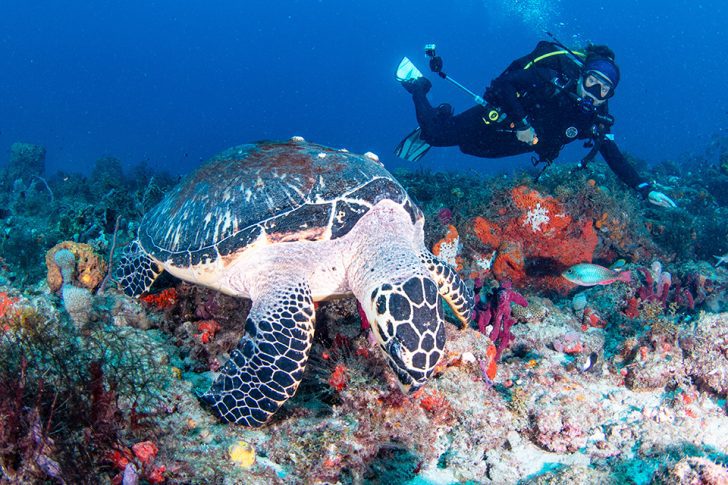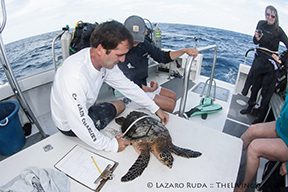by John Lidington, Contributing Writer
Imagine looking up while taking a photo to find a sea turtle peering over your shoulder, checking out what you’re doing. Not what you would expect from these normally shy creatures, but it happened to avolunteer working with Dr. Larry Wood on the Florida Hawksbill Project (Dr. Wood’s work is fully permitted by the federal and state governments).Usually it’s the project volunteerswho seek out turtles. This time, the turtle sought them.
Such behavior doesn’t surprise Dr. Wood. He’s been studying hawksbill turtles for almost twenty years. He says our Palm Beach County hawksbills seem to show much less concern about divers than other species of sea turtles. In his work, he has to “boat”a turtle, or slowly bring it up from the bottom and get it on board a boat where he and his team can collect data. Once onboard, theyweigh, measure, tag, and take blood samples from it. To a turtle, thismust seem like getting a full-body probe aboard a UFO. Yet even when Dr. Woodhas re-encountered a “probed” turtle on a dive, it typically shows no increased wariness.
In addition to their acceptance of divers, our Palm Beach hawksbills have another characteristic that is important to those who want to see them—they’re year-round residents. Unlike the loggerhead, green and leatherback sea turtles that we see primarily during the late-spring, early-summer nesting season, the odds of a diver spotting a hawksbill are about the same any month of the year.
Dr. Wood’s research provides a plausible reason for this. After hatching, all sea turtles “disappear” into the open ocean. After a few years this pelagic phase ends and they reappear in nearshore waters as sub-adults. Once they reach sexual maturity, theturtlesreturn to waters off the beaches where they hatched. For our local population, DNA analysis shows most come from the Yucatan Peninsula. Their average length is only about 20 inches longand they rarely show signs of sexual maturity. So, it appears we have a population of sub-adults that has come up with the prevailing currents and is taking a few years to bulk up before heading back to their native beaches.
In support of this idea, Dr. Wood has found that hawksbills in the Florida Keys are smaller than their cousins to the north. That is consistent with juveniles leaving the currents of the Gulf of Mexico for the shallow waters of the Keys, then growing as they slowly work their way northward. His work in the Keys is still in its early stages, with many questions looking for answers. You can learn more about his research, and that of others, at http://savetheseaturtle.org/.
So, as a diver, how do you do to see a hawksbill? Dr. Wood’s tagging and tracking studies show that individual hawksbills stay within relatively small territories for extended periods of time. Give Pura Vida Divers a call (561-840-8750)!Diving where Hawksbills are commonlyseen willincreaseyour odds. Pura Vida Diversknows about recent hawksbill sightings, and can tell you when they will have trips running to those areas.
During the summer, you can learn more about sea turtles from Dr. Wood and even observe hatchlings making their way to the water during Pura Vida Diver’s Sunrise Sea Turtle Education Walks. These walks are scheduled throughout July and August, so contact Pura Vida Divers to sign up: 561-840-8750 or visit www.puravidadivers.com.
Remember, hawksbills are a critically endangered species—they are protected by state and federal law. That means it’s illegal to disturb them, which the law defines as doing anythingthat causes them to alter their behavior. However,if you’re drifting through habitats likely to attract hawksbills, there’s a good chanceyouwillget to enjoy their presence on the reef. Dr. Wood found Juno Ledge and the Trench were prime hawksbill territory, as were the wrecks of the Amaryllis and Mizpah. Encounters are never a sure thing. But, if you’re really lucky, you might just look up and discover that one has found you!
John Lidington from Pura Vida Divers Singer Island, Fl
www.puravidadivers.com


